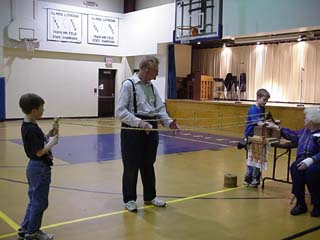

|
Zion Lutheran School Celebrates National Lutheran School Week [MARCH 7, 2000] Zion Lutheran School, located at 1600 Woodlawn Road, is celebrating National Lutheran School Week. This year’s theme is, "Shine Like Living Stars." Students of all ages began the event-filled week with yesterday’s Hobbies and Careers Day. The PTO organized a day’s worth of activities to expose the students to nearly 50 different professions.
|
||||||||||||||||
|
Field trips to visit businesses on site included: Logan Lanes, Kroger, Wendy’s, Elder Custom Cycle, The Courier, Lincoln Animal Clinic, Christian Village, Cracker Barrrel, Graue Chevrolet, Archery and Hunting Club, and Photography with Debbie Skelton. Other area business persons brought their craft to Zion. Activities and presenters were: Mapmaking with Kim Larson, Candy Making with Cindy Ayars, Swing Dance with Audra Turley, Wire Beads with Laura Davidson, Rope Making with Edgar and Analina Coers, Truck Driving with Dennis Rekart, Cake Decorating with Roberta Rademaker, Counted Cross Stitch with Pam Conrady, Woodworking with Peggy Meyer, Amazing Science with Mr. Boyd, Farm and Home Safety with Betsy Pech, Rubber Stamping with Judy Awe, First Aid with Marsha Dowling, Theater Workshop with Vicki Brinton, Eye Care with Dr. Nobbe, Farming with Jim Drew, Finger Weaving with Fay Boerma, Hair Care with Paula Landess, Air Brush Painting with Tom Alberts, Creative Memories Scrapbooking with Carol Runyon, Tae Bo with Carla Bender, and Magicians with Chris Sprinkle. Baby-Sitting, Antiques Show, Bass Fishing Skills, Civil War Costumes, Paper Quilting, Race Car Engines and Skin Care were also showcased.
|
At 10 this morning an Illinois Air National Guard helicopter landed in front of the school. Later today students will present a talent show. The schedule for the remainder of the week is as follows:
Other activities scheduled for this week include Blue and Gold Day, Walking Art Day (students will wear T-shirts they have made), and Shorts in March Day. [LDN]
|
|||||||||||||||
|
Police Ask Citizens’ Help to Combat Meth Labs [MARCH 7, 2000] The methamphetamine labs that are a growing problem in Central Illinois pose many different hazards, according to Master Sergeant Bruce Liebe of the Illinois State Police. Ingredients used to make the drug can maim or even kill. The labs are a fire hazard, and the toxic waste they produce is destructive to the environment and costly to clean up.
|
||||||||||||||||
|
In addition, the drug is so addictive that it completely dominates the lives of users. "Their whole lives revolve around the drug," Liebe said at a seminar held yesterday at the Lincoln Park District. "Their children don’t matter, their relationships don’t matter, their work doesn’t matter. All that matters is meth." To fight this problem, law enforcement agencies in Illinois are asking for help from people in the community. Because the drug can be made entirely from legal substances that are easy to get, police would like farmers, merchants and ordinary citizens to report thefts or large purchases of substances meth "cooks" need. There is more than one recipe for the drug, Liebe said, but all of them start with common over-the-counter cold and asthma medications containing ephedrine or pseudo-ephedrine. Piles of empty bubble-packs that once held these pills could be one sign that a meth lab is in the neighborhood. Although one person can legally buy only two packets of these pills at a time, a meth manufacturer can visit more than one store, until he or she has accumulated the thousand pills used to make an average batch of the drug. Merchants who notice large and frequent purchases of these products should inform the local police department and if possible give a physical description of the purchasers. The most popular meth recipe in Central Illinois uses anhydrous ammonia, a liquid fertilizer. Right now there are many tanks of anhydrous sitting in farmyards and fields ready for spring use. Farmers who think the tanks may have been tampered with should notify authorities, and if they see a suspicious car in the vicinity should make a note of the license number. Lithium batteries are another staple, along with a solvent such as ether, starter fluid, fuel for a camp stove or a similar substance. Another ingredient is hydrogen chloride gas made from sulfuric acid. Some recipes also use red phosphorous and iodine crystals, muratic acid, freon, acetone, hydriotic acid and denatured alcohol. Any merchant who sees an increase in sales of products containing these chemicals should also inform the local police department. The contents of garbage cans sometimes provide clues to the presence of a meth lab, Liebe explained. Empty containers of starter fluid, ether cans with holes punched in them, products such as Heet, drain cleaner cans, salt containers and stripped-out lithium batteries indicate meth is being produced nearby. Other clues are coffee filters and used glass containers containing white residue (sometimes pink if that was the color of the pills the cook started with).
|
A pervasive odor of ether or a strong smell of ammonia can also indicate a meth lab in the area, he said. Every pound of meth produces five or six pounds of very toxic residue, Liebe said, and meth users are not careful how they dispose of it. Toxic waste has been dumped in farm waterways and fields where it kills fish, animals, and all vegetation. Often it is put in dumpsters or even city sewers. The cost to clean up the average meth lab, which must be done by a hazardous waste contractor, is from $5,000 to $10,000. Manufacturing meth is a dangerous occupation. "Most anhydrous thieves have some type of injury," Liebe explained. The volatile liquid can cause burns on the hands and face and, if accidentally splashed in the eyes, blindness. He noted that if a quart of the ether used in the meth manufacturing process is ignited, "It could blow up a small house." The hydrogen chloride gas is also very deadly. "A little can put you down and a little more can kill you, and those makeshift labs usually aren’t properly ventilated." The meth labs don’t look like a science setup with sophisticated equipment, he pointed out. Blenders, hot plates, plastic bottles, glass jars, duct tape and plastic tubing like that used in an aquarium are common utensils. Most of the equipment needed to make meth can be stored in a small space, such as a chest cooler. In Illinois the first users were adults in their 30s and 40s, according to Lincoln police, but the recent raid on a meth lab in the San Jose area turned up users of high school age as well. "There is more and more use in this age group," Liebe said. Sometimes it’s like raiding a school bus." "We are so concerned about this that we’ve dedicated an officer from our police force to work on the drug problem," said Lincoln Police Chief Richard Ludolph. "He works in the District 9 area of Central Illinois with state Drug Enforcement Administration." Ludolph said that Illinois legislators have toughened the laws and the prosecutors are now able to get stiffer penalties for drug manufacturers. "Overall we are fortunate we live in Logan County when it comes to drug sentencing," he said. "Our legal system here has always aggressively prosecuted drug dealers, much more aggressively than in some other counties in Central Illinois. We have sent some to prison for 10 to 15 years." The informational seminar was sponsored by the Alcohol, Tobacco and Drug Task Force of the Healthy Communities Partnership. A second seminar is scheduled for Monday, March 13, at 6:30 p.m. at Lincoln Junior High School, 208 Broadway.
|
|||||||||||||||
|
Part 1 of 3 Lincoln's Helping Hands Reach All the Way to Africa Barbara O’Donohue on the way to Kenya [MARCH 6, 2000] What is on your agenda for this week? If you could sneak a peek at one Lincoln woman’s daily planner, it might look like this: This week’s agenda: Go to a small, remote village in Africa. Stay in "mud huts, graciously shared by the most wonderful people you could meet."
|
||||||||||||||||
|
Owner and president of a Lincoln-based business, General Consulting Services, Barbara O’Donohue left the States March 5th for a return trip to Kenya. She will be working as a volunteer for the Children of Pokot Educational Fund (COPE), an organization she helped found. The Pokot village she will be visiting is located in the country of Kenya, in the Kacheliba District. This will be one of Ms. O’Donohue’s shorter trips, taking four weeks instead of the usual five or six. She will be working with tribal leaders, women, educators and other villagers.
How did Ms. O’Donohue, a Lincoln businesswoman, first connect with a village in Africa? The story begins with Sam Poghisio, a Kenyan who attended Lincoln Christian Seminary. Poghisio was an exile from Kenya when he arrived in Lincoln in the early '90s. He came on a scholarship to Lincoln Christian Seminary. Back in Kenya Poghisio had been a member of Parliament. He was expelled from the Parliament during a difficult political time. Poghisio’s strong stances had provoked those in power, and his safety was endangered. Shortly after Poghisio came to Lincoln, his wife, Pauline, joined him. Mrs. Poghisio was about to give birth to the couple’s first child and had been unable to attain a visa. After the birth of their daughter, Chelimo, Mrs. Poghisio was granted a visa and came to join her husband. Poghisio earned his master of divinity degree in 1993, and the family returned to Kenya the following year. He took a professorship at Africa’s largest Christian university, Nairobi’s Daystar University. He resumed his works for his people and was elected back into the Parliament of Kenya in 1998. Paul and Mary Boatman of Lincoln were traveling with Poghisio in 1995. During that visit in a remote village of the Pokot province, the Boatmans learned of the needs of Pokot. They observed children milling around, children who should have been in school. There are no schools readily accessible in the remote area around Pokot. Poghisio explained to the Boatmans that the children of this village grew up without education. The boys became tribal warriors, and the girls married the boys.
|
Poghisio dreamed of educating the children of Pokot, and asked his well-educated sister if she would go there to teach. She agreed. Poghisio’s sister opened school under a tree. After seeing the children and meeting the villagers during her visit to the village, O’Donohue caught the vision. She came home inspired by the wonderful people. With the support of the Boatmans and other Lincolnites, she took on the leadership to establish COPE, which has helped the school to grow. Later, the class moved to a shelter, a grass hut where the children sat on dirt floors. Since then, a new building has been constructed, and the school children will soon move into it. The little schoolhouse has a concrete floor, tin roof and no desks. It is divided into five rooms. Poghisio smiles and says proudly, "The children will no longer have to sit in the dust."
Four teachers and 150 children are looking forward to moving into the new school. They now claim one of the highest enrollments in the district, and the school is one of the few offering a Bible-based education. Lincoln people have joined the Boatmans and Ms. O’Donohue in supporting the schoolhouse in Pokot. Sam Poghisio recently returned to Kenya after a brief visit to the States. He was here with many other world leaders on an invitation to the National Prayer Breakfast in Washington, D.C. The members of the U.S. Congress hosted the breakfast, with the President and Mrs. Clinton also in attendance. Poghisio swung though Lincoln to see some of his friends here and to express his great appreciation for the people who support COPE.
|
|||||||||||||||






